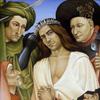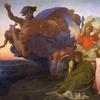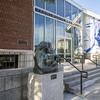Norton Simon Exhibition Explores Duchamp's Influence on Pop Art
- PASADENA, California
- /
- February 07, 2016
The Norton Simon Museum presents Duchamp to Pop, an exhibition (from March 4 to Aug. 29, 2016) that examines Marcel Duchamp’s potent influence on Pop Art and its leading artists, among them Andy Warhol, Jim Dine and Ed Ruscha. Approximately 40 artworks from the Museum’s exceptional collection of 20th-century art, along with a handful of loans, are brought together to pay tribute to the creative genius of Duchamp and demonstrate his resounding impact on a select group of artists born half a century later. The exhibition also presents materials from the archives of the Pasadena Art Museum (which later became the Norton Simon Museum) that pertain to two seminal exhibitions there—New Painting of Common Objects from 1962 andMarcel Duchamp Retrospective from 1963.
In 1916, Duchamp (1887–1968) wrote to his sister, “I purchased this as a sculpture already made.” The artist was referring to his Bottlerack, and with this description he redefined what constituted a work of art. The readymade was born.
The original Bottlerack was an unassisted readymade, meaning that it was not altered physically by the artist. The bottle rack was a functional object manufactured for the drying of glass bottles. Duchamp purchased it from a department store in Paris and brought the bottle rack into the art world to alter its meaning. The act of choosing a readymade allowed Duchamp to, as he said in a 1953 interview, “reduce the idea of aesthetic consideration to the choice of the mind, not to the ability or cleverness of the hand.” Thus, Duchamp privileged the artist’s concept and intent over the details of form.
In 1963, at the prompting of Pasadena Art Museum Director Thomas Leavitt, Curator Walter Hopps embarked on what was to become Duchamp’s first major museum retrospective. A self-described “Duchamp addict,” Hopps had first met the artist in 1949 through Los Angeles-based art collectors Walter and Louise Arensberg. After establishing the Ferus Gallery and promoting the local avant-garde, Hopps arrived at the Pasadena Art Museum well prepared to tackle this ambitious paean to Duchamp, one that would necessitate loans from private collections and art institutions, as well as the re-fabrication of several lost works.
Duchamp’s persistence and intellectual approach, his definition of the everyday object as art and his sense of wit and irony established him as the forefather of conceptual art. He was quintessential to many of the stylistic movements of the latter half of the 20th century, including Pop Art, a moniker derived from the essence of “popular culture.” His retrospective in Pasadena, at the age of 76, garnered critical attention and praise, and brought him into the sphere of many of the young artists who revered him.
From the mid-1950s forward, Pop Art emerged as a response to the post-war acceleration of production and consumerism, and it became the predominant art movement of the 1960s. An inundation of media imagery and advertising led artists to reflect on the world as it was being marketed to them. At first glance, Pop Art can be seen as the antithesis of conceptual art, but below its slick surface, it is a thoughtful, occasionally flippant, critique of commerce and advertising. The use and depiction of everyday items allowed Pop artists to challenge the nature of marketing, explore identity representation and counter the heavy-handed emotional intensity of previous generations, such as the Abstract Expressionists.
By the early 1960s, Pop Art had made its way into modern art galleries, but had yet to be recognized in the hallowed halls of museums. Then, in 1962, one year prior to the Duchamp retrospective, Hopps organizedNew Painting of Common Objects at the Pasadena Art Museum. Widely regarded as the first Pop Art exhibition in a museum, it brought together works by Dine (b. 1935), Robert Dowd (1936–1996), Joe Goode (b. 1937), Phillip Hefferton (1933–2008), Roy Lichtenstein (1923–1997), Ruscha (b. 1937), Wayne Thiebaud (b. 1920) and Warhol (1928–1987). On view from just Sept. 25 through Oct. 19, 1962, the highly influential exhibition marked a turning point for the movement (the term Pop Art was deliberately kept out of the show’s title) and for many of the young artists featured.
Duchamp to Pop
While not a recreation of either of these two exhibitions, Duchamp to Pop features 13 Duchamp works, most of which were part of the retrospective, along with the Duchamp-designed exhibition poster. These pieces (including a replica of his 1914 Bottlerack) are installed together with iconic works by all eight of the artists who were featured in the New Painting exhibition, as well as other pivotal Pop artists. (The exhibition poster from that show, designed by Ruscha, is also featured.) Shown side-by-side, the artworks vividly illustrate the connections between these two generations of artists. Duchamp’s L.H.O.O.Q. or La Joconde, a common postcard of Leonardo da Vinci’s Mona Lisa on whose face he drew a mustache, stares across at Warhol’sJacqueline Kennedy II (Jackie II), a silkscreen of the grieving first lady at her husband’s funeral. These two famous faces, considered icons of feminine beauty, demonstrate both artists’ fascination with identity and popular culture.
Duchamp to Pop is organized by Curatorial Associate Tom Norris. The exhibition is on view March 4 through Aug. 29, 2016, in the Museum’s lower-level exhibition gallery. A series of related events, including lectures, films, tours and performances, will be offered. More information is available at nortonsimon.org.









100x100_c.jpg)




